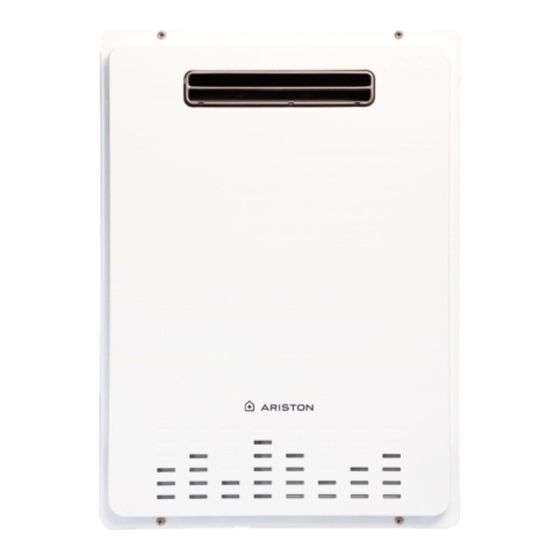Ariston NEXT EVO X OUTDOOR 26 Manual del usuario - Página 21
Navegue en línea o descargue pdf Manual del usuario para Calentador de agua Ariston NEXT EVO X OUTDOOR 26. Ariston NEXT EVO X OUTDOOR 26 44 páginas.

Before installing the appliance
The appliance heats water to a temperature below boiling.
It should be connected to a a domestic water mains supply,
that must correspond in size to the performance and its
power of the appliance.
Before connecting the appliance, it is first necessary to
perform the following operations:
- Carefully wash the system piping in order to remove any
screw thread or welding residues, or any dirt which might
prevent the appliances from operating correctly.
- Make sure that the appliance is set up for operation with
the type of gas available (read the information on the
packaging label and on the boiler data plate).
- Make sure that there are no obstacles inside flue exhaust
and that it does not contain any discharge from other
appliances, unless the flue is meant to serve more than
one user (in accordance with current legal requirements).
- Where there is already a connection to existing flue
exhausts, check that these exhausts have been
perfectly cleaned and are without residues, because any
disconnection could obstruct the passage of fumes and
create potentially dangerous situations.
- Make sure that, where unsuitable flue exhausts are
attached, they have been ducted.
- In areas with particularly hard water, limescale may build
up on the components inside the appliance and reduce
its overall efficiency.
A-type appliances not intended for connection to a flue gas
exhaust or a device for channelling combustion products
outside the premises in which it is installed.
THE APPLIANCE CAN ONLY BE INSTALLED
OUTDOORS OR IN A PARTIALLY-SHELTERED
AREA, AND THE SPACE IN WHICH IT IS
INSTALLED MUST NOT BE ENCLOSED.
Flue gases are discharged through a forced draught
system.
The appliance must be installed on a solid, non-
combustible, permanent wall to prevent access from the
rear.
When creating a space for the boiler, the minimum
distances (which ensure that various parts of the appliance
may be accessed after it has been installed) should be
respected.
installation
Avvertenze prima dell'installazione
L'apparecchio serve a riscaldare l'acqua ad una
temperatura inferiore a quella di ebollizione.
Esso deve essere allacciato ad una rete di acqua sanitaria
dimensionata in base alle sue prestazione ed alla sua
potenza.
Prima di collegare l'apparecchio è necessario:
- effettuare un lavaggio accurato delle tubazioni degli
impianti per rimuovere eventuali residui di filettature,
saldature o sporcizie che possano compromettere il
corretto funzionamento dell'apparecchio;
- verificare la predisposizione dell'apparecchio per il
funzionamento con il tipo di gas disponibile (leggere
quanto riportato sull'etichetta dell'imballo e sulla
targhetta caratteristiche);
- verificare che il luogo di installazione dell'apparecchio,
in ambienti esterni, consenta un'areazione ed una
ventilazione naturali, senza zone stagnanti per i prodotti
della combustione, che devono essere rapidamente
dispersi per convezione naturale o dal vento.
- in presenza di acque con durezza particolarmente
elevata, si avrà rischio di accumulo di calcare con
conseguente diminuzione di efficienza dei componenti
dell'apparecchio.
Gli apparecchi tipo A sono apparecchi non
destinati ad essere collegati ad un condotto
di scarico dei fumi o ad un dispositivo per
l'evacuazione dei prodotti della combustione
all'esterno del locale in cui è installato.
L'APPARECCHIO
INSTALLATO SOLO IN UN AMBIENTE
ESTERNO O IN UN LUOGO PARZIALMENTE
PROTETTO
INSTALLATO
CHIUSO.
Lo scarico dei fumi è a tiraggio forzato.
Per non compromettere il regolare funzionamento
dell'apparecchio il luogo di installazione deve essere
idoneo in relazione al valore della temperatura limite
di funzionamento ed essere protetto in modo tale che
l'apparecchio non entri direttamente in contatto con gli
agenti atmosferici.
L'apparecchio è progettato per l'installazione a parete e
deve essere installato su una parete idonea a sostenerne
il peso.
Nella creazione di un vano tecnico si impone il rispetto di
distanze minime che garantiscano l'accessibilità alle parti
interne dell'apparecchio.
installazione
PUÒ
E
L'AMBIENTE
NON
DEVE
ESSERE
OVE
È
ESSERE
21
